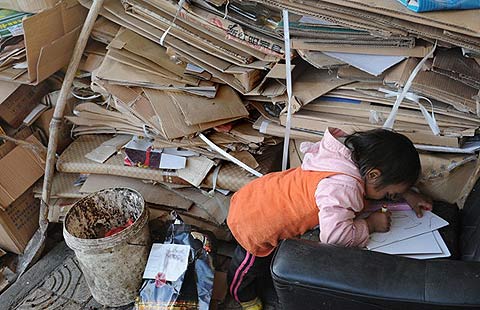Want change? Invest money
Updated: 2014-11-20 14:07
By Leila Gharagozloo-Pakkala(chinadaily.com.cn)
|
|||||||||||
Cash transfers may not be the magic wand, but time after time they are transforming lives
When countries first started supporting disadvantaged households with cash transfers, there was a chorus of concern: it would create dependency, these were hand-outs and would discourage people from working. Five years later, amid scores of countries that are trialing cash transfers and safety net programmes,the sky hasn't fallen in. Indeed, the sun is shining.
A growing body of evidence suggests that social protection measures –withcash grants leading the way– are in fact an innovative, efficient way of reducing poverty. Are they the mosteffective? Perhaps. What's certainly clear is that far from being a cost, they have become an investment.
Borne out of a need to respond to the economic and social vulnerabilities faced bythe poorest, these measures are far reaching.Let the numbers talk: in South Africa, the Child Grant reduced the poverty gap by 47 percent;in Kenya, unconditional cash transfers saw a 19 percent increase in primary school enrolment among ‘hard to reach' children; while inrural Ghana, for every one Cedi transferred, 1.50 Cedi of income can be generated in the local economy. There are few outlaysthat get a 50% return on investment. Except it seems, in Hintalo, in Ethiopia, where 1Birr transferred can bring an 84% return, multiplying to 1.84Birr. These are not mere percentage points. They represent the lives – the improved lives – of people across the continent.
Peoplesuch asWintala and Safia, two mothers (and sadly widows) who I metlast month in Malawi. Both can now send their children to school, provide decent meals and health care to their families, andaccumulate assets. All from a monthly installment of just US$8.
Why does all this matter? In Eastern and Southern Africa alone, nearly half the population lives on less US$1.25 a day and some countries in the region post the highest levels of income inequities in the world.This current socio-economic contextis a concern. One in every 11 children born still dies before their fifth birthday; nearly 20 million children are out of school; and almost half of the world's new HIV infections occur in this region, with a heavy burden directly and indirectly on children.
Such social-economic threats come against a backdrop of an unprecedented demographic shift, according to a recent report by UNICEF, entitled Generation 2030 Africa. On current trends, in the next 35 years, 1.8 billion babies will be born in Africa. By 2050, Africa is projected to be home to one in every four of the world's inhabitants.
Africa's growing population presents an unparalleled opportunity and several challenges. The opportunity lies in the potential for a demographic dividend of sustained rapid economic growth in the coming decades. Investment in the children of Africa is the continent's best hope to set the right pre-conditions for this potentially massive and transformative demographic dividend. Get it right and the continent will see sustained rapid economic growth in the coming decades. Growth that would support a prolonged economic boom that could contribute to dramatically reducing poverty in Africa.
And yet Africa's demographic dividend is far from guaranteed by its changing demographics alone. Reaping it will require the right pre-conditions. Reaping it will require investment. And there is no cheaper and more efficient investment than social protection.
However, without the right pre-conditions, Africa's demographic boom could turn into a demographic burden, with mass deprivation, unemployment and low productivity, with inherent risks to stability and security. History has demonstrated that shared growth is an imperative for development; it has showed that where economic prosperity is not shared, it can be disruptive and destructive.
Fortunately, the benefits of investments in childrenare transformational.Child sensitive social protection is proving to be Africa's most effective instrument for tackling poverty, addressing vulnerability and closing the gap on inequality. This is not to call social transfers the magic wand, but time after time they are transforming lives.
When evidence, momentum and demographics collide, action must follow.Speaking recently at Sixth International Policy Conference on the African Child, GracaMachelnoted that “social protection investment has huge inter-generational impacts”. In the same meeting, former President of Mozambique, Joaquim Chissano, said that “there is no better time to be courageous and to putting in place commitments to comprehensive social protection”.
Surely then this is the moment to ensure all families, even the most excluded and marginalized are reached by social protection. Children are regularly referred to as defining our future. It follows that it is governments' present investment in them that matters most.
Leila Gharagozloo-Pakkala is the UNICEF Regional Director for Eastern and Southern Africa
Today's Top News
Cyber terrorism sparks Internet debate
Editorial: Mob politics rocks HK
UnionPay offers discounts to outbound tourists
Palace Museum opens door to special groups for free
HK police condemn acts endangering public order
Putin receives high-ranking envoy from DPRK
Hebei Steel takes 51% holding in Duferco
Automakers adapt to China's declining luxury car market
Hot Topics
Lunar probe , China growth forecasts, Emission rules get tougher, China seen through 'colored lens', International board,
Editor's Picks

|

|

|

|

|

|





